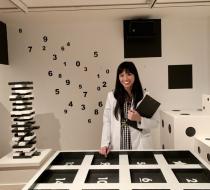The Privilege of Escape Favorite
For an art project about the effects of white privilege and the disturbing ways in which its effects are built into our society, Risa Puno’s The Privilege of Escape is a surprisingly fun, even enjoyable experience.
The first public artwork produced through Creative Time’s new Open Call program, The Privilege of Escape was selected from some 600 applications from emerging artists. The result is an experience that resembles an escape room, the popular immersive puzzling phenomenon, but that also has a serious message about the ways in which members of different groups’ daily experiences diverge in arbitrary and unfair ways.
Puno has incorporated game play into her work in the past, but she hardly counts herself an expert on this particular genre. “I don’t think you get to call yourself an escape room aficionado until you’ve done something like 100 rooms,” she told artnet News at the press preview.
She played her first room, in which players began blindfolded and handcuffed and had to search for a tiny key, with her own family in 2016. The Privilege of Escape sticks to more straightforward logic puzzles, but draws heavily on established escape room conventions. Like every escape room worth its salt, The Privilege of Escape has a theme, inviting you into a fictional scenario. Upon arriving at the sleek glass-walled lobby of the Onassis Foundation in Midtown and descending to the basement, participants are told they are subjects of a research experiment by “The Institute.”
With an eye toward avoiding spoilers, Creative Time and the artist asked that participants in the preview not give its exact details away. In outline, the experience has you divided into teams and locked into the escape room, where participants’ actions are carefully observed and recorded by scientists in white lab coats.
Armed only with their wits—cell phones are strictly prohibited—guests are locked into a spartan, black and white room, filled with locked boxes and cryptic symbols. An ominous countdown clock gives you 45 minutes to make your escape, working together to solve a series of puzzles. At the end of the allotted time, a scientist meets with the research group test subjects to debrief them on their experience.
“The games are designed to require teamwork and communication, which I think helps foster a discussion afterward,” Puno said. “You feel bonded with your teammates.”
The artist was inspired to create the piece because she understands that the concept of privilege can be divisive. The design of the game speaks in subtle ways to how white privilege is not so much an advantage conferred upon white people, but a freedom from the additional obstacles faced by persons of color. (Again, I’m avoiding spoilers.)
“This idea of trying to unlock resources in order to succeed really spoke to life in general but especially this idea of privilege and I thought there were a lot of ways to play with that,” Puno explained. “You feel real emotions, you feel a drive, an urgency. You feel that win!”
Tickets to the escape room are free, but the entire run sold out in about 12 hours. Puno acknowledged that there is some irony in this: “Can you even get a ticket to this privileged activity about privilege?”








